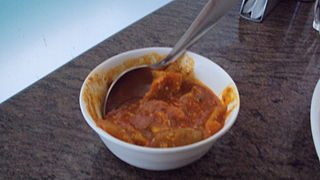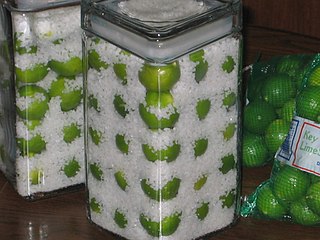This article needs additional citations for verification .(July 2012) |



A mango pickle is a variety of pickle prepared using mango. [1] It is very popular in South and Southeast Asia. These sour/spicy pickles are also available commercially.
This article needs additional citations for verification .(July 2012) |



A mango pickle is a variety of pickle prepared using mango. [1] It is very popular in South and Southeast Asia. These sour/spicy pickles are also available commercially.
The examples and perspective in this article may not represent a worldwide view of the subject.(March 2019) |
The pickling process in India differs from other regions mainly due to an additional spice mixture added to them after anaerobic fermentation.[ citation needed ] Pickles are main side dishes and many varieties of vegetables are used. However, raw mango or tender mango is the most popular variety of fruit used for pickling. There are multiple varieties of mango pickles prepared depending on the region and the spices used but broadly there are two types: whole baby mango pickles and cut mango pickle. Whole baby mango pickle is a traditional variety very popular in Southern India and uses baby mangoes that are few weeks old.[ citation needed ] There are special varieties of mangoes specifically used just for pickling and they are never consumed as ripe fruit. Baby mangoes are pickled using salt, vegetable oil and a blend of hot spices, in a very careful process which ensures pickles are preserved for years. [2]


This is ideally prepared using a special variety of mango that can stay crisp for longer periods when pickled. This variety of mango is specially bred and grafted for use. However, most raw mango varieties can be pickled if quality is not a concern.[ citation needed ]
One of the most popular kind of mango pickles is called the "Avakaya"(ఆవకాయ), also known as "Uragaya"(ఊరగాయ) and it is known for its spice and flavor. It is usually eaten with plain white rice or on the side with other flavored rice items like a hot sauce and is a staple of meals in southern India, especially in the state of Andhra Pradesh.[ citation needed ]
Avakaya (also known as mango pickle [3] ) is a variety of Indian pickle popular in South India with its origin in Delta Districts of Andhra Pradesh. The main ingredients are mangoes, āvapiṇḍi (ఆవపిండి)(powdered mustard seeds) and a combination of other spices used for pickling. South Indians are known to have a deep attachment to these spicy pickles. A wide variety of pickles are available in these regions, using mango as their prime ingredient. Besides being made at home, the pickles are available commercially and are exported to the United States, Europe, Japan and many other countries. [4]
Avakaya pickles are usually made in the summer, this being the time for peak availability of green mangoes. Green mangoes, hot oil, chilies and a variety of spices are the key ingredients. The process of preparation, storage and serving is considered almost a ritual.[ citation needed ]
The mangoes are cut into medium-sized pieces approximately 2 cm x 2 cm using strong and especially sharp cutters/knives in swift strokes so as not to structurally damage the pieces. These pieces are wiped clean and dry with a highly-absorbent soft cloth — usually an old sterilized cotton sari with no embroidery, stowed away for this purpose. They are then pickled with powdered mustard, red chili powder (dried and powdered or sometimes dried, roasted and powdered), salt, gingelly oil. The mixture matures for four to eight weeks, care being taken to mix the contents periodically to ensure a uniform marinade. [5]
Hot rice is mixed with one or two pieces of avakaya and ghee (clarified butter) or groundnut oil, then made into bite-size balls. Avakaya is often eaten with rice and dahi (yogurt). Raw onion can be added which enhances the taste. Most people prefer to eat it along with muddapappu (pigeon pea dal) and neyyi (ghee/clarified butter). Some people prefer to eat it within 1–2 months from preparation, when it is called Kottāvakāya. [5]
This is a variation where mangoes are grated to produce a chutney-like pickle.

This is a variation of mango pickle. This kind of pickle is made from tender mango. [6] The small mangoes are collected when the mangoes just start to grow. In this pickle the mango is not cut into pieces; the whole mango is prepared as a form of pickle.

A chutney is a spread typically associated with cuisines of the Indian subcontinent. Chutneys are made in a wide variety of forms, such as a tomato relish, a ground peanut garnish, yogurt or curd, cucumber, spicy coconut, spicy onion or mint dipping sauce.

Mixed pickles are pickles made from a variety of vegetables mixed in the same pickling process. Mixed pickles are eaten much like other pickles: in small amounts to add flavor and to accent a meal. Mixed pickles appear in many different world cuisines.

A relish is a cooked and pickled culinary dish made of chopped vegetables, fruits or herbs and is a food item typically used as a condiment to enhance a staple. Examples are chutneys and the North American relish, a pickled cucumber jam eaten with hot dogs. In North America, the word "relish" is frequently used to describe a single variety of finely chopped pickled cucumber relish, such as pickle, dill and sweet relishes.

Biryani is a mixed rice dish most popular in South Asia. It is made with rice, some type of meat and spices. To cater to vegetarians, in some cases, it is prepared by substituting vegetables for the meat. Sometimes eggs and/or potatoes are added.

Sri Lankan cuisine is known for its particular combinations of herbs, spices, fish, vegetables, rices, and fruits. The cuisine is highly centered around many varieties of rice, as well as coconut which is a ubiquitous plant throughout the country. Seafood also plays a significant role in the cuisine, be it fresh fish or preserved fish. As a country that was a hub in the historic oceanic silk road, contact with foreign traders brought new food items and cultural influences in addition to the local traditions of the country's ethnic groups, all of which have helped shape Sri Lankan cuisine. Influences from Indian, Indonesian and Dutch cuisines are most evident with Sri Lankan cuisine sharing close ties to other neighbouring South and Southeast Asian cuisines.

Assamese cuisine is the cuisine of the Indian state of Assam. It is a style of cooking that is a confluence of cooking habits of the hills that favour fermentation and drying as forms of preservation and those from the plains that provide extremely wide variety of fresh vegetables and greens, and an abundance of fish and meat. Both are centred on the main ingredient — rice. It is a mixture of different indigenous styles with considerable regional variations and some external influences. The traditional way of cooking and the cuisine of Assam is very similar to South-East Asian countries such as Thailand, Burma (Myanmar) and others. The cuisine is characterized by very little use of spices, little cooking over fire, and strong flavours due mainly to the use of endemic exotic fruits and vegetables that are either fresh, dried or fermented. Fish is widely used, and birds like duck, pigeon, squab, etc. are very popular, which are often paired with a main vegetable or ingredient; beef used to be eaten before British colonialism, and some continue to do so. Preparations are rarely elaborate. The practice of bhuna, the gentle frying of spices before the addition of the main ingredients so common in Indian cooking, is absent in the cuisine of Assam. The preferred oil for cooking is the pungent mustard oil.

Chow-chow is a North American pickled relish.

Pickling is the process of preserving or extending the shelf life of food by either anaerobic fermentation in brine or immersion in vinegar. The pickling procedure typically affects the food's texture and flavor. The resulting food is called a pickle, or, if named, the name is prefaced with the word "pickled". Foods that are pickled include vegetables, fruits, mushrooms, meats, fish, dairy and eggs.
Maharashtrian or Marathicuisine is the cuisine of the Marathi people from the Indian state of Maharashtra. It has distinctive attributes, while sharing much with other Indian cuisines. Traditionally, Maharashtrians have considered their food to be more austere than others.

South Asian pickle is a pickled food made from a variety of vegetables and fruits preserved in brine, vinegar, edible oils, and various South Asian spices. The pickles are popular across South Asia, with many regional variants, natively known as lonache, avalehikā, uppinakaayi, pachadi or noncha, achaar, athāṇu or athāṇo or athāna, khaṭāī or khaṭāin, sandhan or sendhan or sāṇdhāṇo, kasundi, or urugaai.
Goan cuisine consists of regional foods popular in Goa, an Indian state located along India's west coast on the shore of the Arabian Sea. Rice, seafood, coconut, vegetables, meat, bread, pork and local spices are some of the main ingredients in Goan cuisine. Use of kokum and vinegar is another distinct feature. Goan food is considered incomplete without fish.

Asinan is a pickled vegetable or fruit dish, commonly found in Indonesia. Asin, Indonesian for "salty", is the process of preserving the ingredients by soaking them in a solution of salty water. Asinan is quite similar to rujak, which is usually served fresh, while asinan is preserved vegetables or fruits. Of the many types and variations of asinan in Indonesia, the most popular are asinan Betawi and asinan Bogor. Asinan can be found in restaurants, warung, and travelling street vendor.

Chhundo is a kind of Indian pickle preparation as well as a condiment mostly made out of grated green mangoes, used in cuisine of the Indian subcontinent as an accompaniment to the main meal that consists of Roti, Sabzi and other food items. However, it is a generic form of preparation that can be made with various fruits and vegetables. Chhundo is particularly a Kathiawadi dish but is consumed across Gujarat.

Pickled fruit refers to fruit that has been pickled. Pickling is the process of food preservation by either anaerobic fermentation in brine or immersion in vinegar. Many types of fruit are pickled. Some examples include peaches, apples, crabapples, pears, plums, grapes, currants, tomatoes and olives. Vinegar may also be prepared from fruit, such as apple cider vinegar.

Kasundi is the Asian or Bengali variety of mustard sauce or relish. It has the pungent paste of fermented mustard seeds, spices and sometimes dried mangoes, dried Indian plum and olives. Kasundi is popular as a dipping sauce in Bengali cuisine.